History of Osijek
The origins of human habitation of Osijek dates back to Neolithic times, with the first known inhabitants belonging to the Illyrian tribes. Roman emperor Hadrian raised the old settlement of Mursa to a colony with special privileges in 131. After that, Mursa had a turbulent history, with several decisive battles taking place, deciding the destiny of the whole region. After their migration, the Croats made a settlement near the ruins of Mursa, giving it its present name, Osijek. Life was thriving here in the Middle Ages, but only traces of that life can be found today because the Turks destroyed everything they found and made a town to suit their style.
The earliest mentions of Osijek date to 1196. The town was a feudal property of the Korogyi family between 1353 and 1472. The city was sacked and destroyed by the Ottoman Empire on August 8, 1526. The Turks rebuilt it in oriental style and it was mentioned in the Turkish census of 1579. Suleiman the Magnificent built a famous, 8 kilometer long wooden bridge in Osijek, considered to be one of the wonders of the world. The town was officially promoted to a city by the end of the 17th century.
Osijek was restored to western rule when on September 29, 1687 it was occupied by the Hapsburg Empire. Between 1712 and 1721, new Austrian authorities built a new fortress. It is a unique urban and military complex that lies in the heart of the town. Its main central Holy Trinity Square is closed on the north by the building of the Military Command, on the west there is the Main Guard building and on the east is the Magistrate building (presently Museum of Slavonia). In the middle there is a monument to the plague. In 1809 Osijek was granted the title of a Free Royal City and during the early 19th century it was the largest city in Croatia. The city developed along the lines of other central European cities, with cultural, architectural and socio-economic influences filtering down from Vienna and Budapest.
 The town of Osijek is located on the Drava River.
The town of Osijek is located on the Drava River.
 The Tvrdja fortress constructed by the Hapsburgs from 1712 to 1721. To the left is the Water Gate, leading to the river.
The Tvrdja fortress constructed by the Hapsburgs from 1712 to 1721. To the left is the Water Gate, leading to the river.
 A section of the wall and a tower.
A section of the wall and a tower.
 A closer view of the tower, which also served as a water tower.
A closer view of the tower, which also served as a water tower.
 A view of St. Michael's Church.
A view of St. Michael's Church.
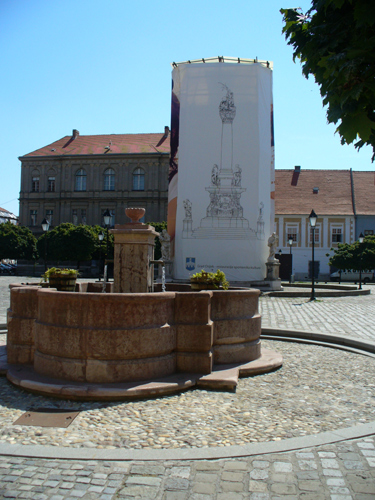 The fountain in the center of Holy Trinity Square. The valves for controlling the flow of water from the water tower also used to be here.
The Holy Trinity Square dates back from the beginning of the 18th century, and it was named after a testament statue "The Holy Trinity", which was erected in 1729
and dedicated to the Holy Trinity with sculptures of the patron saints, protectors from the plague. It is now being refurbished.
The fountain in the center of Holy Trinity Square. The valves for controlling the flow of water from the water tower also used to be here.
The Holy Trinity Square dates back from the beginning of the 18th century, and it was named after a testament statue "The Holy Trinity", which was erected in 1729
and dedicated to the Holy Trinity with sculptures of the patron saints, protectors from the plague. It is now being refurbished.
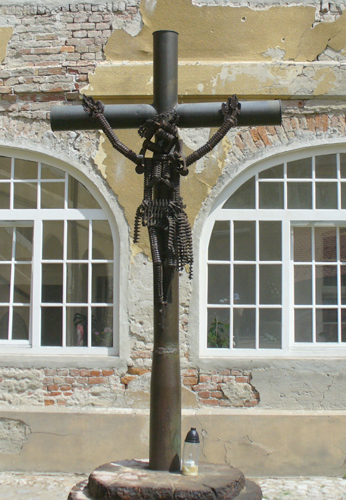

Near the Church of the Holy Cross were a crucifix and a memorial to the holocaust.
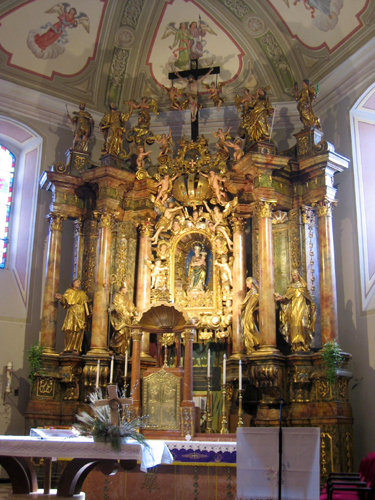 The interior of the Holy Cross Church, also called St. Anthony's Church. The statue of the Holy Mother of God is over 500 years old. This church suffered no damage in the Homeland War.
The interior of the Holy Cross Church, also called St. Anthony's Church. The statue of the Holy Mother of God is over 500 years old. This church suffered no damage in the Homeland War.
 It is also known as St. Anthony's Church because of a painting of St. Anthony which attracted many pilgrims.
It is also known as St. Anthony's Church because of a painting of St. Anthony which attracted many pilgrims.
 For a change of pace we were taken to a folk concert. After the concert, we had our first taste of slivovitz, a plum brandy.
For a change of pace we were taken to a folk concert. After the concert, we had our first taste of slivovitz, a plum brandy.
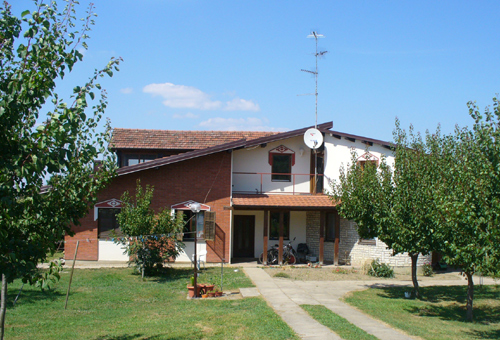 We were then taken in groups of 6 or 8 to a home-hosted lunch. Ours was at this home, where we had some more slivovitz and beer and wine with our lunch.
We were then taken in groups of 6 or 8 to a home-hosted lunch. Ours was at this home, where we had some more slivovitz and beer and wine with our lunch.
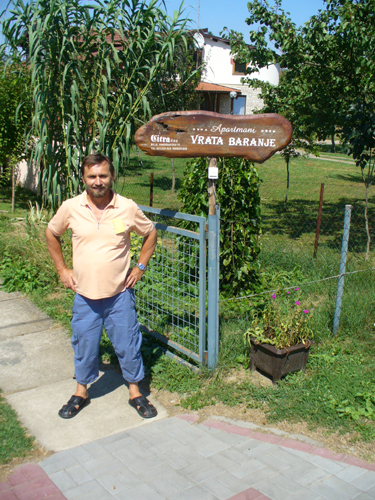 This was our host, who owns a B&B and apartments here.
This was our host, who owns a B&B and apartments here.
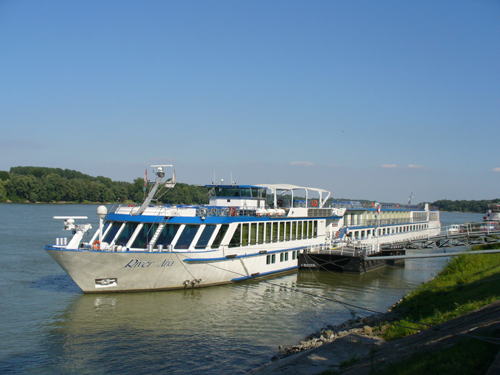 After all our sightseeing and eating and drinking, we were happy to see the River Aria, which was waiting for us in Mohacs, Hungary
After all our sightseeing and eating and drinking, we were happy to see the River Aria, which was waiting for us in Mohacs, Hungary
The ship would take us overnight to Budapest.
